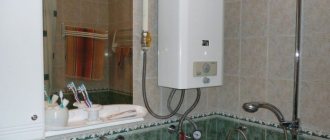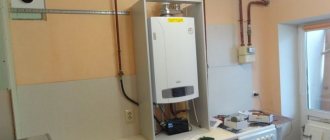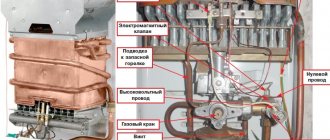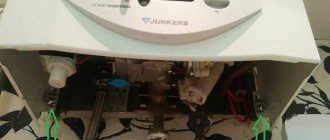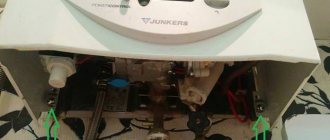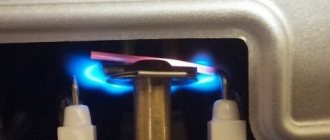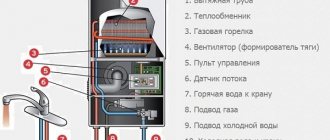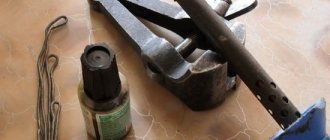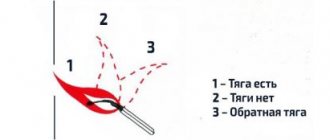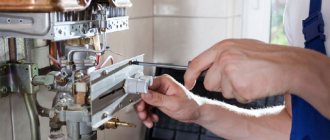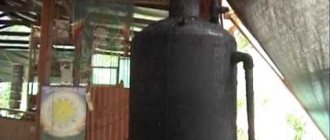Why is there no draft in the chimney?
There can be several options for the lack of draft in the chimney:
- Soot deposits have narrowed the passage in the smoke channel;
- bricks collapsed and the cross-section of the smoke channel decreased;
- the spider made a web, and the wind blew leaves;
- the birds made a nest.
If there is no draft in the chimney, the consequences can be very sad. Therefore, all gas instantaneous water heaters are equipped with a draft sensor.
Tips: Before you start inspecting the chimney ducts, remove the draft sensor and check its functionality. First, disconnect the wires from the traction sensor, and then connect them together. If the column lights up without a sensor, it means it is faulty.
Check for traction with a lit match. If the flame is drawn into the channel, then everything is in order with the draft.
Malfunctions requiring mandatory contact with a specialist
There are two main reasons why a geyser goes out:
- one of three emergency sensors is triggered: traction, overheating or combustion;
- the column is clogged, which makes it completely impossible to ignite.
Initial actions in cases where the unit stops working:
- To exclude the first option, you need to make sure there is no smell of gas, and draft is carried out in the chimney. If this is detected, you need to call a professional to clean the smoke valve.
- The overheating sensor turns on if the heat exchanger is clogged or the control automation does not work. Its purpose is to protect the copper coil. In this situation, ventilate the room and wait until the unit cools down. Contacting a specialist is mandatory, since only a trained gas technician can properly regulate the column after descaling it.
- If the third sensor is triggered, the gas supply is automatically shut off. In fact, this sensor is a regular thermocouple. If there is a flame, a current is generated and gas is passed through the solenoid valve. When the fire goes out, the valve shuts off the fuel supply for 10 seconds. In this case, you can hear a characteristic sound reminiscent of snapping fingers.
Algorithm of actions when turning off the thermal mechanism:
- stand for 10-15 minutes (to cool the sensors);
- chimney draft is checked;
- the presence of gas is checked;
- the room is ventilated;
- an attempt is made to start the unit (put the power knob in the position required to turn it on, keep it on for 20 seconds, press the “piezo igniter” button);
- if the actions taken did not lead to the desired result, the functioning of the combustion sensor is checked;
- the non-working state of the combustion sensor can be caused by contamination of the pipe, which operates on the principle of a vacuum cleaner, so it should be thoroughly cleaned;
To clean the device that supplies combustion gas (pipe), the following actions are carried out:
- the handle that regulates the water temperature is removed;
- the required ignition position is set;
- the surface of the gas device is removed;
- use a screwdriver to lift up the pipe clamps located on top;
- These clamps are placed separately;
- by moving the lower clamp, the pipe is removed;
- the tube on which dust is collected is washed under running water and cleaned using cotton swabs and swabs;
- a prerequisite for normal pipe cleaning is the removal of all traces of detergent and water;
- the nozzle also undergoes thorough cleaning;
- the tube is installed back into the device, starting from the top mount, where the springy end is located;
- for the lower fastening, you will need to apply enough force to secure the pipe tightly;
- the clamps are put back in their original place;
- a second attempt is made to ignite the column by simultaneously turning on the piezo ignition and power regulator;
- handles and buttons are held in this position for at least 10 seconds;
- The temperature adjustment knob is inserted into its original place.
In addition, the most common reason for the damping of a geyser is described in this video:
Despite the enormous competitiveness of the water heater market, the Junkers gas water heater remains in a leading position. Great popularity has been achieved through the introduction of innovative solutions and properly designed designs. But due to design features and Western standards, Junkers HSVs are susceptible to leaks and breakdowns when used in Russian conditions.
Reviews about the installations are mostly negative and most indicate that Junkers water heaters break down within a couple of years after the warranty expires.
Read in the article
Design and principle of operation
A typical column consists of a casing that is connected to the chimney through a pipe, a heat exchanger (the best is copper), a gas burner, an ignition system, sensors and a mechanism responsible for supplying gas. The gas water heater is connected quite simply.
Its operating principle can be examined on a model that has piezo ignition.
- The slider is set to the middle position, after which you need to click on it. At this moment, the valve opens and gas enters the wick, also known as the igniter.
- The piezoelectric element, located at the bottom left of the gas column, supplies a spark that ignites the gas. In this case, the slider button is kept pressed for up to 40 seconds. When it is released, the wick still continues to burn.
- At this time, the thermocouple of the column is heated, which will then keep the electromagnetic gas valve open.
Why does the speaker turn off during operation?
If the gas water heater lights up normally, but for some reason goes out during operation, this may indicate that the device’s security system is functioning properly.
The column design has a sensor that is triggered when the internal temperature rises. There are two plates inside the system that repel each other, stop the power supply, and turn off the column. This happens when your core temperature rises quickly and uncontrollably.
You can check the sensors by resistance. A working part shows an infinity sign. When a different value is displayed, we call a technician.
If the device works for a long time and then turns off, check the settings. Sometimes users accidentally set it to turn off automatically after a certain time.
What else causes the shutdown:
- poor water or gas pressure;
- broken contact between the thermocouple and the solenoid valve (you need to clean the contacts and tighten the connections);
- oxidation of the power supply contacts, when the device clicks but does not light up.
It is also useful to check the batteries. Standard replacement of power supplies is carried out every six months. Batteries hold a charge longer.
Traction is poor or completely absent
The accumulation of combustion products is most often associated with clogging of the chimney with soot, soot, and debris. When there is no traction or it is insufficient, the work is not carried out.
It is important to remember that the flame can go out due to external factors - gusts of wind, for example. The draft in the shaft increases or decreases under the influence of a draft
You can clean the chimney through the “pocket” located 25 cm below it. If such manipulations do not help, call the utility company.
Soot accumulation on the heat exchanger
During operation, the heat exchanger accumulates soot, soot, and scale. When it becomes clogged, the color of the flame changes from yellow to blue.
How to clean the heat exchanger:
- We remove the casing.
- Unscrew the screws holding the casing.
- We turn off the water supply.
- Open the faucet to drain hot water.
- Disconnect the heat exchanger thread and tap. You will need a stand as water may leak.
- Prepare a solution of hydrochloric acid (3-5%).
- Take a pipe with a diameter of 1/2” or use a hose.
- We connect one end to the input, the other to the output.
- Pour the solution into the funnel. If foam appears when washing, this is normal.
- As soon as a strong pressure appears at the outlet, we stop the procedure.
While working, be sure to wear gloves. After descaling, you need to thoroughly rinse the heat exchanger to remove acid residues.
If during the cleaning process defects were noticed on the tubes, then the heat exchanger will have to be repaired.
It is recommended to carry out cleaning work once a year. Regular maintenance will help the device function properly.
Clogged shower head and hose
It happens that the gas water heater turns on and for some reason immediately goes out when switching to the shower. This may be due to clogged holes in the watering can.
You need to unscrew the watering can, clean and rinse the holes. Soaking metal elements in a solution of citric acid is also effective.
The next part that can cause the wick to go out is the shower hose. If it gets tangled or clogged, the pressure power decreases and the column goes out.
The mixer can also break or become clogged. You need to disassemble it, check it, clean it if necessary.
At the entrance to the water supply unit there is a filter that retains small debris. It is also useful to clean it periodically. To do this, unscrew the screws, remove the element, rinse, and clean with a brush with citric acid.
The influence of a thermocouple on the operation of a gas water heater
This device signals the presence of flame on the igniter. The operating principle is based on the appearance of an electromotive force when two dissimilar metals are heated. The thermocouple tube is a minus. It is attached to the body of the gas water heater, and the central rod is a plus. If the contacts are broken or oxidized, the signal in millivolts will not be sent to the actuator - the solenoid valve. Accordingly, gas will not flow into the column.
Tips: Pay attention to the gasket that isolates the ground from the center wire. If it is damaged, the thermocouple will not work. You can only check the functionality of the thermocouple with a voltmeter
Heat the thermocouple with a candle flame and measure the voltage at its ends. If the readings on the voltmeter increase, then it is working properly.
You can only check the functionality of the thermocouple with a voltmeter. Heat the thermocouple with a candle flame and measure the voltage at its ends. If the readings on the voltmeter increase, then it is working properly.
How to determine that there are internal faults in a gas water heater
The reasons why the water heater goes out may be the following:
- filters are clogged;
- the membrane is deformed.
If the quality of water supplied to the room is unsatisfactory (for example, hard, with a large amount of lime impurities), the metal filter grid becomes clogged. To restore the normal functioning of the unit, it is necessary to clean (replace) the mixer filter. Cleaning can be done with conventional detergents to remove rust and scale.
It is also important to clean the column itself from soot formations.
To examine the membrane, the bolts that secure the front panel of the speaker are unscrewed.
When inspecting the membrane, attention is paid to its shape (so that there are no deformations) and the presence of any chips. If such defects are detected, it must be replaced.
And it is better to choose a silicone membrane, since its surface is more durable and elastic
If such defects are detected, it must be replaced. And it is better to choose a silicone membrane, since its surface is more durable and elastic.
In this regard, the service life of this part will be longer.
To install the membrane, it is better to use the services of specialists, which will undoubtedly be safer. In addition, when you call a technician, you can simultaneously carry out a general cleaning of the unit and conduct a full diagnostic of the device.
The reasons for the attenuation of the gas column may also be the following:
- unequal pressures of hot and cold water, which can be solved by simply regulating the water supply;
- lack of cold water before starting the unit, which, by the way, leads to rapid damage to the column;
- insufficient time to hold the ignition button (20 seconds is the required duration);
- There is a malfunction of the flue gas sensor, which can be determined by calling.
Internal factors causing attenuation of the gas column
The reasons why the Junkers gas water heater does not work may be the following:
- the batteries have expired;
- the membrane is damaged (for example, it ruptured in one or more places);
- malfunction of control sensors;
- plugged and/or clogged pilot burner;
- worn-out condition of the micro-switch (no clicking sound);
- the water fittings are jammed due to the formation of rust on them;
- dirty condition of the filter element, as a result of which the water flow is limited;
- During installation, the inlet and outlet for water supply may have been confused;
- the electrical circuit is in a damaged state (for example, broken);
- the valve on the gas pipe may be accidentally closed;
- the electrodes are clogged (there is no proper contact), which leads to failure of electric ignition.
Varieties
In general, all Junkers speakers can be divided into three groups, depending on the ignition method.
- Those that belong to the B series do not have an igniter that can burn continuously. Two batteries are responsible for ignition, and the speaker itself turns on automatically. Safety systems control draft and flame, there is a fuse. The water pressure in the water supply affects the temperature.
- The P series operates on the basis of piezo ignition. This means that the igniter does not stop working. Water and power have to be adjusted separately.
- Finally, the G series models work thanks to HydroPower technology. There is no igniter at all, and a hydrodynamic generator is responsible for ignition.
The models produced are standard and mini. The difference between them is only in size. Prices for Junkers brand products are determined based on dimensions and additional services such as delivery and installation. Reviews are most often positive. Users only mention the need to timely clean equipment and remove blockages.
Preference is most often given to Junkers brand models with piezo ignition. When the hot water tap opens, gas will flow to the main burner. As a result, it will ignite from the pilot and heat the water.
Cleaning the heat exchanger, descaling
One of the common malfunctions of geysers is insufficient water heating
. As a rule, the reason for this is the formation of a thick layer of scale inside the geyser heat exchanger tube, which prevents the water from warming up to the set temperature and reduces the water pressure at the outlet, which ultimately leads to increased gas consumption by the geyser. Scale is a poor conductor of heat and, covering the heat exchanger tube from the inside, forms a kind of thermal insulation. The gas is open to full speed, but the water does not warm up. Scale forms when tap water is more hard. You can easily find out what kind of water you have in your tap water by looking into the electric kettle.
Junkers speakers - malfunctions and methods for eliminating them
Descriptions of breakdowns and methods for troubleshooting Junkers geysers are given in the table:
| Malfunction | Elimination | |
| The pilot burner is blocked. | Clear. * |
| There is insufficient gas supplied. |
|
| Water temperature is too low. | Check the position of the power regulator and set it to a higher power. | |
| The burner turns off while the appliance is operating. |
|
|
| Reduced water flow. |
|
|
| *can only be done by a service and repair technician |
Today, many residential premises continue to use gas water heaters. Dispensers are a great way to use hot water if your apartment or house has gas and water supply. Very often, hot water in apartments is turned off for the entire summer period. Everyone tries to make their life more comfortable through their efforts. For many, installing a gas water heater is the only solution. You can read about how to properly turn on a gas water heater in this article.
Many consumers are confident that using geysers at home is life-threatening, as a gas leak may occur or the water heater may explode
Previously, old-style speakers were installed in homes, which could fail if the owners ignored safety precautions when using them. Modern geysers are a new type of device with automatic protection
You should not use outdated models of geysers - they require an extremely careful and careful approach, which will make its use extremely inconvenient. In order to ignite an old-style column, you must use manual ignition. Modern devices turn on and work automatically in most cases.
Methods for turning on units:
- Manual ignition.
It is mainly suitable for igniting older models. Earlier to light the column. It was necessary to use matches to light the wick. First, it was necessary to open the water supply, which was connected to the column. Then open the main valve, and then make sure that gas is supplied to the ignition wick. The pilot wick continued to burn even in the absence of water pressure. The speaker had to be turned off manually. At home, using speakers of this type is not advisable. - Piezo ignition.
In many types of speakers this element is installed. When you press the button, the wick in the combustion chamber ignites. The ignition wick ignites due to the mechanical force causing a spark. To turn on the main burner, it is necessary to activate the main regulator, which supplies gas. - Automation.
Modern modifications involve automatic ignition of the wick and main burner. The turbine is responsible for this; it turns on due to the water pressure. The only problem with the operation of such a column may be insufficient water pressure.
When installing modern speakers, you can be sure that they are safe to use. In order to use them you do not need special knowledge and skills. But if the column breaks down, you need to contact the gas service directly. Repairing speakers yourself is strictly prohibited.
Is your Junkers geyser broken?
Geysers Junkers are German quality, time-tested. Geysers Junkers P series - mechanical activation of the pilot burner, the so-called piezo ignition. The columns have an igniter, separate water and gas regulators, control of the flame in the main burner and exhaust gases is carried out by a thermoelectric system, the so-called gas control. Geysers Junkers series B - these models do not have an ignition group. The column is started from two batteries when the water tap is opened. Equipped with the same control system as described above. Geysers Junkers G series - the whole beauty of this series is that the ignition and start-up of the device comes from a hydrogenerator - HydroPower technology. Very comfortable and modern model.
The main malfunctions of Junkers geysers can be the following: 1. the igniter does not light (when the button is released, it goes out, in the case of piezo ignition);
2.
when turned on, there is a clap;
the main burner does not light up
(in case of piezo ignition);
3
.
during operation of the column, the main and ignition burners are switched off
;
4
.
the column does not reach the desired hot water temperature
;
5. lack of spark
when opening a hot water tap;
6. the column turns off
after ignition in 1-2 seconds;
7. there is a spark, but does not ignite (in the case of electronic ignition)
; carries out high-quality repairs of your Junkers speaker in the shortest possible time at your home! Departure of the master in a short time in Moscow and the Moscow region. We use only original spare parts. We have the most affordable prices. Our specialist will help you solve all the problems associated with the Junkers geyser.
Gas water heaters are designed to heat water in apartments and houses that do not have hot water supply. They have recently become popular heating devices among the population, both private houses and residential apartments. They are often bought by families with children, as interruptions in the supply of hot water are becoming more common these days.
The most popular models of geysers are easy to use, they are safe and quickly allow you to regulate the degree of water heating in the house. In this article we will look at how the Junkers gas water heater works and is repaired. .
External signs of a geyser malfunction
If the junkers gas water heater does not light up, the reasons for this may lie in external factors not related to the condition of the main equipment.
- Incorrect piping. In this case, it is necessary to check the connection of both the inlet and outlet pipes, which will also ensure an uninterrupted water supply.
- No traction. This is usually caused by the chimney being clogged with a large amount of dust or foreign objects. Thus, combustion products are not removed and the burner goes out. In such a situation, you need to bring your hand to the chimney or a small flame (from a match or lighter). An important condition is the presence of an open window. If the draft level is sufficient, the flame will be deflected, and air movement will be felt on the palm.
- There is an unpleasant smell of gas in the room, which may be caused by neighbors installing an antenna above the chimney. In this case, you must immediately turn off the water heater, ventilate the room and call special gas services.
- The column ignites, but after a while it fades out. This may be caused by excessive “sensitivity” of the protective relay. In such a situation, it is necessary to cool the room by opening the windows and contact service to replace the relay.
- A discharged battery or battery may also cause the automatic ignition unit to not operate. This indicates the need to replace them, which you can do yourself.
- Low water pressure may indicate a malfunction of the junkers geyser if the water pressures, for example, in the bathroom and in the kitchen, are different. If they are equally small, then the reason is a weak water supply network.
- Extinguishing the wick can be caused by an oblique, uneven flame. As a result, poor heating of the thermocouple occurs, which automatically turns off the unit. In this case, it is necessary to clean out the dust, which is a mandatory preventive measure when the wick goes out.
The junkers column goes out the wick
Important
If the pressure is equally weak at both water intake points, then the reason lies in the water supply network.
- The thermocouple automatically turns off when heating is poor. This problem can occur when there is a slanted and uneven flame.
Also, the condition of the column is affected by its operating time.
If you are using an old device and are having problems with fire, then one of the components may have failed. In this case, you are unlikely to be able to do without the help of a specialist.
Possible faults
Of course, the operation of any equipment does not always go smoothly; you should be prepared for anything. Fortunately, a significant part of the possible malfunctions that occur with a Junkers geyser can be easily resolved on your own.
There are actually many reasons why the burner does not light.
- It may turn out that both the inlet and outlet pipes were initially installed incorrectly. In addition, the water supply may be disrupted.
- Possible problems with traction. When the chimney is dirty, combustion products do not escape, but accumulate inside, which slows down the operation of the equipment. Craving also suffers due to the lack of fresh air, for example, when the window is closed.
- It happens that the chimney becomes blocked, and this creates a potentially dangerous situation. We urgently need to turn off Junkers and call specialists.
- If the pilot flame goes out, this indicates that the protective relay requires replacement.
- It may simply turn out that the burner does not light because the battery is discharged, and therefore the automatic ignition system does not function. You will have to disassemble the front panel and charge it yourself or replace the battery.
- Low pressure in the main leads to poor water supply, which again leads to operational problems.
- The wick goes out when the flame is uneven. As a result, the main burner also turns off. To solve this problem, simply clean the device.
Sometimes the Junkers speaker does not light up, and sometimes the device turns itself off.
- The first reason is that the batteries have become unusable.
- The second reason is that it is necessary to change the membrane, which has become deformed or torn. It's good when the repair kit contains a replacement.
- The next possible option is that one of the control sensors does not work or the microswitch is worn out, this can be determined by the absence of a characteristic click.
In addition, the igniter may become clogged from the inside, which can be easily fixed by cleaning. An abundance of rust, dirt in filters due to poor quality water and electrodes leads to similar consequences. Finally, improper installation, a closed valve on a gas pipeline, and problems with wires are also common causes of service interruptions.
There are several more common cases. If there is no spark in a device with autostart, then perhaps there is no ionization current, which means water is not flowing. The spark goes out when the flame controller is broken. If the column does not heat water, the reason may be perforation of the water block membrane, contamination of the tubes or improper assembly, but most often, a breakdown of the heat exchanger.
When the water heater makes excessive sounds and gets hot, this indicates that the radiator is broken or clogged with scale.
You can learn how to light a Junkers gas water heater from the video below.
Malfunction at the Junkers gas water heater - the malfunction igniter goes out
In accordance with the requirements of regulatory and technical documents in force in the Russian Federation, maintenance and repair of gas consuming equipment must be carried out by a specialized organization that has a certificate of admission to this type of work, as well as duly certified personnel. Call the service technician accordingly.
Sergey N wrote: The serviceman may suggest short-circuiting the thermocouple if this is the reason. I would not advise you to agree to this; if you turn it off, the column will work, but this does not guarantee its further safe operation.
A serviceman from an official service will NEVER OFFER this, since he is responsible for his actions according to the law, as evidenced by the contract, work order.
But “Uncle Vasya is a jack-of-all-trades” - easily! Or he may not offer it, but silently do it “as it should,” and he is not responsible for the consequences! Now the time has come to write an article not about computers and 1Ski, but about repairing a Bosch/Junkers WR13 gas water heater. Who would have thought that an IT specialist would climb there. It’s a tradition that such things are best left unchecked in the departments of gas companies and without special knowledge. In fact, there is nothing terrible there, and with more or less straight hands, you can do it yourself. Moreover, there is a crisis in the country and you want to save money. It all started when the heater stopped going off when the hot water was turned off, so I had to run and turn off the gas manually. Googling suggested that two main blocks are responsible for this: hydraulic fittings (water unit) and gas fittings. They are connected together in such a way that when water is supplied, the water unit, using a membrane pressing on the pin, presses on the gas valve, thereby opening the gas supply. When the water is turned off, the gas valve closes. In general, the problem is somewhere here! (number 14 in the picture)
So, let's get started... Here is our patient: All we need is 2 screwdrivers (Phillips and flathead) and a wrench to unscrew the nut securing the water pipe. For safety, we will cut off the water and gas supply to the apartment. Remove the protective casing by unscrewing the two screws from the bottom:
We gain access to the insides: Remove the bracket securing the water supply pipe to the heat exchanger:
We take out the pipe itself:
We unscrew the two screws securing the water unit to the gas fittings: And then I saw a picture of oxides at the attachment point. The mechanism was blown apart and water leaked out. The metal oxidized and began to jam the gas valve (it stopped returning to its original position). This is the reason for not turning off the gas supply! Let's try to clean everything as much as possible and develop the valve itself: It should be pressed inward and return to its original position. Now let's look at the water block itself:
We take out the bracket and take out the flow regulator (sleeve with a spring):
Unscrew the bolts and remove the water unit cover:
Under it we see a worn-out membrane: And the cover itself has fallen apart over time (the column is currently 7 years old):
As it turned out, spare parts for gas water heaters are not so easy to find. And the prices for them, frankly speaking, are outrageous. With the price of a new Bosch Junkers GWH 13 P (WR13-2 P2) speaker – 10,000 rubles. I found the cheapest membrane in the city (code 8700503083) for 1,400 rubles. and water fitting cover WR10, 11, 13, 15 (code 8705500105) for RUB 2,400. Total 3600 rub. More expensive than a third of the column. So before you start repairing, think about whether it is necessary. But it was already too late... the column was disassembled and I didn’t want to install a new one, so I decided to continue what I started! (although I almost freaked out and didn’t go for a new Chinese one for the same money) The picture shows old and new parts. The difference is immediately visible:
Now we install a new membrane and water valve cover, assembling everything in the reverse order:
Hooray. Everything worked out for me. Now the flame lights up and goes out as it should! What do you want to say in the end?! When I was puzzled by the choice of column 7 years ago, Junkers were praised as the most reliable and repairable. I find it difficult to say whether 7 years is a lot or a little for reliability, although the old Soviet ones still work for people and at least they care! But at such prices for spare parts, this maintainability is not needed. Now I would choose the cheapest Neva or Chinese Oasis for 4-5 thousand rubles and if it breaks, I would simply throw it away without worrying and install a new one for the price of repairing this Junkers/Bosch. One hope is that this prevention will allow the column to work for at least as long... And finally, for those who don’t understand the pictures, I’ll give a link to a video on disassembling Bosch/Junkers gas burners from the company Teplotekhnika St. Petersburg: https://www. youtube.com/watch?v=a2aIn93fyQ8
_______________________________________________________________________________
The Junkers gas water heater is in operation. There are problems with it, you turn off the hot water, but it continues to set fire without gas. The piezo ignition just keeps clicking until you turn it off. Tell me what can be done?
Use an ohmmeter/multimeter/visually to check the microswitch on the water block, its wiring, and correct/replace inoperative parts.
At 25 degrees the column does not emit anything at all, and at 50 degrees there is an ignition spark. Could it be that the device is new and already needs to be disassembled and cleaned?
What is the inlet pressure? At a pressure of less than 1 bar, it is, in principle, normal that there is no startup when the bypass is open. In general, mechanical speakers work best with an input pressure of 2-3 bar. You need to put the chimney in order, then the column will not turn off, set the right knob to the maximum temperature and then simply adjust the temperature with the left gas supply knob. Many people use them this way without any problems.
The Junkers WR-13 column is in use. Her igniter (the thing that ignites the gas) is clogged. The gas burns unevenly and then goes out (at the igniter). Tell me how to clean it?
Disassemble and clean.
Malfunction of the Junkers 275 battery-powered gas water heater. I open the water, it lights up, the water comes out hot, everything is fine. But after 40 seconds it goes out. When you start the water again, the column does not light up, but only after a click, after 10 seconds. Tell me what is the problem? I lengthened the chimney, but it didn't help.
Lack of traction. Elbow 90 degrees -1.5m of the chimney. Plus it is right above the column, where there should be a vertical section of at least 700mm. To connect this way, you need a device with a turbine. Extend the chimney, make a vertical section directly above the column, remove all narrowing diameters. The upper part of the column, where the draft breaker is, should not heat up above 50 during operation. Hot gas should not come out of the draft breaker; you can simply check it by hand. With good traction, almost everything there is cold.
Malfunction of the Junkers WR 10 geyser. I bought it six months ago, connected it today, the pilot light is on, the water flows normally, but the heating does not start. Tell me, what can I do with it myself? How can I check the gas supply valve?
Even if the column is to blame, then it is not the gas part, but the water part (frog) that will be to blame! Disassemble/assemble!
Junkers geyser in operation. I set the gas and water pressure regulators so that it was somewhere around 45 degrees. And today I noticed that the pressure seemed to have become stronger. If, for example, yesterday you open a hot tap to full, it runs mediocre and the temperature seems to correspond. And today you open it as usual (it started in the evening) and the pressure is felt stronger. I checked the water pressure - 3 atm. That is, the pressure has become the same as it used to be through an electric boiler. When I installed the column, I noticed that the pressure was weaker. But I thought that this was due to the flow sections of the main body. But today the pressure has increased, and most importantly, the water has become barely warm and the gas is going out. I set the gas to maximum and the water to maximum hot. The indicator shows 65-70 degrees, but in reality it is less. Warm good water, but not 70 and the pressure is good. Understood nothing. We'll keep watching. I didn't turn anything other than the standard knobs on the panel. I think maybe the gas pressure has dropped (I’ll measure it tomorrow), but what does the increase in water pressure have to do with it, and it shows 70 degrees. Or it’s not her water temperature, but like she “wants” to heat it to this temperature, but it doesn’t work. I forgot to say, the water is clean without mechanical impurities. There is a filter.
First, of course, check the gas pressure. About the pressure. We need to pay attention to the flow. If it is not adjustable with the right handle, you need to sort out the water block. In any case, if the gas goes out at its normal inlet pressure, the modulator is faulty - the rod is stuck, the springs are broken, etc.
Nothing is clear from the instructions. My water flow regulator is in the middle. We will not touch the gas regulator, for simplicity of reasoning, we will simply set it to maximum. So, the water flow is in the middle. The modulator adjusts to the set temperature and maintains the required gas pressure on the burner. Now we reduce the water flow with the regulator. In theory, the water temperature should begin to rise, and to prevent this from happening, the modulator removes the gas. Vice versa. We increase water consumption. The water temperature drops, and to prevent this from happening, the modulator increases gas flow. Am I thinking correctly? That is, at maximum flow, the gas should burn as much as possible. But for me it goes out when the flow rate increases. That is, everything is the other way around. This is what is not clear. It looks like everything inside is thoroughly stuck. You can't do it without complete disassembly.
The modulator adjusts only to the inlet duct. The flow control knob sets the point of its regulation. That is, if both handles are, say, in the middle and for some reason the flow rate has increased, the modulator increases the gas supply. But if you reduce the flow rate with the right handle, the flow rate decreases and the control point also changes, the gas remains the same, and therefore the water becomes hotter. And then it regulates in the same way relative to this new flow point. It is not the temperature that is set by the handle. Flow is set. The regulator feedback is based on flow, and not on temperature.
The Junkers gas water heater has been operating for four years without any complaints. And then the other day it started to malfunction. In general, it works for 15-20 minutes and then goes out. You turn the water off and on, the igniter lights up, and after a few seconds it goes out, and you can do this no matter how many times, it doesn’t light up. A little time passes - it works, and everything repeats again. The water pressure is wonderful, as is the gas pressure. What could be the reason?
The traction sensor is cooling down. It looks like there is a problem with traction. Bad traction. There is no air flow. The heat exchanger is clogged after being in operation for four years. Look into the working column from bottom to top at the heat exchanger grill (add gas, it will be better visible); if it’s red, it needs to be cleaned. It wouldn't hurt to clean the burner itself from dust.
Malfunction of the Junkers WR-13 geyser. The water began to heat up poorly. The flame height has visually decreased. I took it apart and cleaned it, but it didn't help. Connected to the pipe that leads to gas. the stove and everything worked, i.e. there was not enough gas pressure. But another problem arose: the gas pressure was not regulated. What could be the problem?
There is a hole in the membrane of the water block; because of it, the gas valve does not open completely. Check and replace the membrane. Soon it will stop running altogether. Restrictions and thin flexible hoses lead to insufficient gas pressure. The rod of the water unit is driven by a membrane; if it is intact and not stretched (the latter is also important), then something is preventing the valve from opening completely. Perhaps the rod is stuck, the water block is assembled incorrectly, the venturi tube is clogged, or the channels in the water block body are clogged. Again, all this is true at normal gas pressure at the inlet when the column is turned on. It must be checked and corrected first, otherwise you can start looking for faults in a working column. The gas control knob is a regular tap. If the flow is already limited by something at the inlet before this tap, then this tap will have virtually no effect on the flow, so the flame height does not change when adjusting the gas supply knob.
Malfunction of the Junkers WR-10 column. Installed by a master. Turns on great. But it does not hold the temperature, although there is a temperature control function. Setting the temperature to warm, the water is either cool or hot (for about 10 seconds, sometimes it lasts a little longer, but most often it jumps quite quickly). The pressure in the house is not the strongest, but sufficient for the speaker to work. Maybe you have some thoughts. What could be the reason for the constant change in temperature?
Perhaps the gas pressure is simply unstable, or the device was connected with a flexible line with a narrowing diameter. We received positive feedback on gas pressure. The column tries to regulate the temperature by changing the power of the burner, while the gas pressure jumps due to a narrowing of the diameter of the supply or a too long gas pipeline of insufficient cross-section. As a result, the temperature controller enters the zone of unstable operation; physics has not been canceled. Let him measure the static/dynamic pressure and correct the connection. In general, it is not clear how you accepted commissioning that was not carried out properly. And it was also necessary to take it with continuous modulation. There is no dependence of the regulatory effect on gas pressure; the regulator operates entirely from the power supply.
Column Bosch Junkers WR-13-2. Installed two years ago. From the very beginning there were problems. The first time I couldn’t light it for about half an hour. Something was stuck there, and the column did not want to light up. Then something clicked and it seemed to start working. And so it worked for two years, lighting up every other time. And now I’m starting to get really weird. The display shows a temperature of 40 degrees, and the water flows a little warm. You turn the temperature up to normal to wash yourself, but the display shows 62 degrees!
The thermometer there has no connection with the gas supply and burner power. It's just a thermometer. Well, this what’s-its-name generator. With our water and its pressure, this is often a useless device. And sometimes it works, but there is not enough power, especially during ignition, since at this time the maximum current is consumed. Treatment is switching to batteries.
Checked, the symptoms are exactly the same - ignition every other time, puffing, etc. since the spark is weak and cannot ignite the burner. At a minimum, for starters, connect the power from two new R20 alkaline batteries in parallel (without mixing up the polarity, red is positive, and the connection should be 1.5V, not 3). Regarding the thermometer - if it is lying too much - most likely the temperature sensor has gone sour, replace it.
Please tell me the electronic unit of Junkers gas water heaters, why might it fail? Explanations from the service technician due to power surges in the network. I somehow don’t understand, it’s not connected to the network. Who has encountered this?
We will try to help you. The same model is installed in the house. Having not worked for even a year, the column gave the first failure - the burner stopped turning on (but the igniter caught fire). The reason is a breakdown of field-effect transistor Q2 in the electronic control unit (without it, the circuit does not sense the burning igniter and does not want to open the burner valve). I replaced the broken transistor with a KP303V (KP303B should also work). It turned out great, however, a month later it was rejected again. I replaced the transistor again, but it barely lasted a couple of months. For the third time, replacing the transistor (Q2), I bypassed its gate circuit with a varistor type 390KD07 (39V), i.e. added a new component to the circuit. This protection turned out to be sufficient - the speaker has found a new life and has been happy for 3 years!
A Junkers WR 275 gas water heater is in operation. Everything works, lights up, heats up, but here’s a question. The gas (twist) handle is in the small light position, and the water handle is in the middle. We open the tap, the water comes out warm as set, but then after 5-6 buckets of water it becomes cooler, and significantly 10 to 15 degrees lower than the original. At the same time, no one regulated the water pressure; it neither decreased nor increased, and the water became colder. It only helps if you close and then reopen the tap and the process repeats. No one has turned the device, it’s new, is it supposed to be like this or should the water always flow at the same temperature as set?
Observe the burner flame. For the temperature to change by 10-15 degrees, the flame must change quite significantly, it is difficult not to notice it. Well, the water flow should also be constant. If the flame does not change, the flow does not either, which means that the temperature of the water at the entrance to the column simply changes; as soon as colder water reaches from the underground part of the water supply system, the temperature changes, and this column should not maintain it.
I bought a speaker, connected everything, when I open the tap I hear the sound and the fire control light comes on. The flame lights up and immediately goes out! The cold water continues to flow, the smell of gas appears until I close the tap, apparently it is coming. Column faulty? There seems to be a draft, I tried it in the same pipe as the boiler, it burns and works. The water pressure is 3 bar, the gas pressure is unknown, but the boiler is working at 30 norms. At the moment, of course, it is turned off, since it is summer.
If the control LED lights up before the flame appears on the burner, the electronic unit is most likely faulty, or the electrode wire or the control electrode itself is shorted to the housing. The solenoid valve may not be sealed if there is a smell of gas when the tap is open and the burner is off.
Malfunction of the Junkers gas water heater. It takes a very long time to tinker with its ignition. Piezo ignition. At first you have to hold the button for a long time (about a minute). Then the piezo igniter somehow does not ignite it (rarely). Well, it doesn’t bother me anymore, we’re used to it. We light it with a match after holding the button for a minute and a half (apparently so that the gas accumulates). Then, when the wick is still lit, hold the button for about a minute and only then move it to the right. Tell me, what could be wrong?
The ignition burner tubes and its nozzles are clogged, the channels in the gas tap are clogged with hardened lubricant, carbon deposits on the thermocouple are due to which it cannot warm up quickly and hold the EMC.
The Junkers WR 275 geyser is in operation. After cleaning, it does not heat the water well. I washed the heat exchanger, washed the burner, washed the membrane and all the filters. Before cleaning there was a lot of soot on the heat exchanger, the flame was uneven, red in places with long tongues in the area of the ignition group, soot was also mostly in the middle. Now the flame is blue and even, but the water temperature is very low and practically does not respond to the water and gas supply regulators (knobs). The water pressure, gas pressure, exhaust are normal, the ignition group is new (pipe, ignition electrodes), only changed the day before yesterday. The water comes out warm, if you greatly reduce the pressure, it becomes warmer, about 45 degrees, before cleaning it gave out almost boiling water. The device is 10 years old. Maybe you can tell me what could be wrong with her?
The Venturi tube may have become soured (or stuck due to rust). You need to clean the tube, gaskets (rings), installation site and lubricate everything with silicone grease.
The Bosch gas water heater has been in operation for five years now. Power regulator at minimum. The flow regulator is fully open. Every year the temperature of the water produced by the column increases. Hot water must be diluted with cold water. If you open the cold one a little more, the column goes out. Is there any other way to reduce the water temperature?
Only by limiting the gas, a screw filled with paint can be sealed, but before this manipulation it is necessary, if available, to check the coarse water filter. Clean if necessary.
Malfunction of the Junkers 275 gas water heater. Previously, it heated the water very well, but a couple of days ago the water started running at 25 degrees, when I set the power lever to the extreme position and the flow knob to minimum and back, there was no response from the water heater. At the same time, the radiator was flushed, the main burner was cleaned and the water unit was rebuilt.
Maybe the gas pressure in the network has dropped. This can be especially noticeable if the column is connected with a thin hose. Maybe the gas filter is clogged. Maybe something else. It seems that this column allows for adjusting the gas pressure in front of the injectors, but it is better to have this done by a specialist.
I installed a Junkers WR-10 gas water heater a year and a half ago to replace the old Soviet one. And I didn’t know grief until now. And now she started heating the water worse and worse. The water in our city is hard, but the water pressure at the outlet is still normal and strong, and the heater is also not dusty. Maybe someone has instructions? Where to even start repairs, what to pay attention to?
To begin with, measure the flow of cold and hot water on one mixer in liters/min. Then you can understand how clogged the heat exchanger is. Next: 1) cleaning the water reducer. Carefully! we disassemble, check the cleanliness inside, check the integrity of the membrane. 2) cleaning the gas burner (remove, rinse and blow with compressed air). 3) cleaning the heat exchanger from the outside. (see paragraph 2). It should help.
Other sources of the problem
Let's look at other problems that cause the problem of column attenuation after ignition.
The fading of the wick may be due to the presence of powerful ventilation near the column. Exhaust air is drawn into the ventilation, which leads to attenuation. It is necessary to turn off the ventilation or turn its power down to minimum while the gas heater is operating.
For the same reason, you should not place a powerful hood next to the column. During its operation, sensors may be triggered, diagnosing a malfunction.
Sometimes the reason is hidden in the lack of natural ventilation. It is necessary to open the window or install a supply valve.
The wick can also be extinguished in models with piezo ignition. The button must be held for at least 10 seconds.
Also, during operation of the heater, it is not recommended to mix hot and cold flows. This leads to a drop in pressure in the line and damping of the wick.
The problem is solved by adjusting the indicators to a comfortable level and reducing the pressure with a special handle. If you still have to mix water, you need to leave the hot stream as the main one.
Attenuation may be caused by a malfunction of the solenoid valve or servomotor. Only calling a specialist will help here.
The water assembly membrane is the main element of the column
All instantaneous water heaters use membranes for safe and stable operation of geysers. This is the only element in instantaneous water heaters that has not undergone fundamental changes. When you open a hot water tap, the pressure in the water unit increases, the membrane puts pressure on the gas valve stem. The rod can make dozens of such moves per day. To audit a water node you need to:
- Shut off the water and gas flowing to the column.
- Remove the flame and water control knobs from the front panel.
- Disconnect the water unit from the heat exchanger. To do this, use a 24 mm wrench.
- Unscrew the 2 screws securing the water unit to the gas unit and remove it.
- Remove the 5 screws holding the cover in place.
- Inspect the condition of the membrane. To do this, it must be squeezed tightly because small holes are difficult to notice.
If the membrane is damaged, replace it with a new one.
Conditions conducive to breakdowns of the Junkers geyser
The following factors can cause a gas unit to break down:
- lack of the required amount of oxygen, which is necessary for the proper operation of the equipment;
- simultaneous opening of cold and hot taps;
- lack of necessary regular equipment maintenance to facilitate timely detection and elimination of breakdowns;
- the use of long gas hoses, which cause a decrease in gas pressure.
Recommendations for safe use
If you are interested in the manufacturer Junkers, you can purchase a gas water heater from this company in any store of relevant goods at an affordable price. However, you must follow rules that will ensure the safe operation of the equipment. Replacing the device is not a panacea for troubles that arise during the operation of the device - this is what reviews say. Junkers geysers rarely become the cause of dissatisfaction that arises from the quality of the device. If you want to get a speaker that will serve for a long period of time, then you should follow the operating instructions.
Maintenance, as well as installation of the device, should be carried out by professionals; these manipulations should not be trusted to people who do not have sufficient specialized knowledge
It is important to clean the heat exchanger and igniter from time to time, which act as fundamental factors for the correct and stable operation of the unit
If you are interested in the manufacturer Junkers, a geyser from this supplier will certainly please you with its quality characteristics. However, in order not to speed up the end of operation of the device, you should not experiment with very high heating temperatures of the coolant, as this can accelerate the process of deposits that form in the heat exchanger. If the water in the system is sufficiently hard, it is recommended to supplement it with Anti-Scaling, which will extend the life of the column.
The junkers column goes out the wick
This can lead to scale formation in the heat exchanger.
- Too hard water can be purified by installing a hydromagnetic system that will remove all hard substances and salts.
- Regular cleaning of the gas water heater and chimney will benefit the device.
- It is not recommended to turn off electronic speakers at night, as frequent interruptions in electronic systems can lead to system breakdown.
The fact that the protective relay of the gas water heater overheats can trigger its protection, which will explain the reason why the water heater does not turn on. To avoid this, you should either ventilate the room more often to normalize the temperature of the relay, or completely replace it.
Operating rules
It should be remembered that some actions can lead to damage to the gas water heater. Junkers operation will be disrupted if fresh air is not provided. In addition, breakdowns will occur when using too long hoses, which lead to a decrease in pressure and the simultaneous opening of hot and cold taps. Naturally, the lack of periodic prevention will also lead to negative consequences.
It was already indicated above how you can turn on the Junkers column - this is done using a valve and a piezoelectric element that can light the wick. Once you light the burner, it will work throughout the day. Moreover, as soon as the hot water tap opens, the boiler will be connected automatically. You can change the gas pressure and water pressure by switching two control knobs.
If you decide to clean gas equipment, this is done according to a certain algorithm.
- First, the gas and water are turned off, then the casing is removed.
- At the next stage, the water unit and smoke receiver are dismantled.
- Finally, the heat exchanger is removed at the end. The radiator can be washed in warm water with a non-abrasive cleaning solution added. The brush should be long-haired and quite stiff.
- The wick and main burner can be easily cleaned using a special awl. In addition, you will have to remove carbon deposits from each injector. However, it is not recommended to do this yourself. It is better to invite a specialist once a year who will combine an inspection with descaling. The professional will also remove deposits, check the tightness of the fittings and clean the plates on the flue gas side.
If there is a smell of gas, it is prohibited to use electrical switches and telephones in the area where the gas burner is located.
It is important to immediately turn off the gas tap, open the windows, ventilate the room and call the specialists who installed the equipment. To prevent dangerous situations, do not store liquids or objects prone to ignition near Junkers.
When the room temperature drops below zero degrees, the burner turns off and empties. If such a procedure was not carried out before the winter months, then when connecting the device the next season, you need to check whether the water is heated.
Service center for repair of geysers LLC "TeploSpetsCenter"
Today it is impossible to imagine a city apartment without a gas water heater. - This is the most affordable and reliable equipment for heating cold water. The column simultaneously supplies hot water to several water supply points - to the faucet in the kitchen, to the faucet and shower in the bathroom. A breakdown of the unit entails a lot of everyday inconvenience.
Regardless of their service life, speakers from even the most recognized manufacturers sometimes fail. Insufficient water heating speed, yellow or green flame in the burner, loud hum during operation, black soot flakes are typical consequences of non-periodic or unqualified maintenance of units.
Breakdowns and repair methods for speakers
The main reason for the failure of a gas instantaneous water heater is mechanical or natural wear and tear of the working elements of the device. Mechanical wear includes cracking of the membrane gasket, failure of the solenoid valve, and combustion of the thermocouple. Natural wear and tear of components is clogging of the water purification filter, contamination of the heat exchange unit, clogging of pilot tubes and burner nozzles.
The wick fades after releasing the gas button
This is the most common device failure. The cause of the breakdown is a clogged igniter channel or failure of the bimetallic sensor.
To eliminate the malfunction, you should call a service center technician. The technician will clean the column, thereby extending the service life and warranty of the water heater.
The column does not heat the water quickly enough
It happens that the column does not heat running water quickly enough, and when cold weather sets in, it does not work at all. Check the integrity and flexibility of the membrane gasket. If cracking or loss of flexibility occurs, replace the membrane with a new element. If the structure of the membrane is not damaged, clean the surface of the gasket and put the element in place.
To ensure that the dispenser operates without failures, perform maintenance on the unit once or twice a year. To do this, it is recommended to contact our company. The first maintenance is carried out before the onset of winter cold, and repeated maintenance is carried out in the spring, after the heating season has passed.
The column locks after a few minutes of operation
Check the air draft in the chimney duct. To do this, attach a sheet of paper to the chimney opening. The sheet of paper should be held on the wall by the flow of outgoing air. The second way to check traction is with a burning match. Place a burning match near the chimney opening and observe the flame. If the flame rushes towards the chimney, the draft is normal; if it deviates from the channel, the draft is broken.
To restore air draft, clean the chimney of soot, dust, and small debris. To conduct a complete audit of the gas exhaust system, contact specialized companies. Trained engineers will conduct a comprehensive system check using special equipment.
Repair of geysers at the customer’s address
Regulatory requirements prohibit the dismantling of gas instantaneous water heaters that are connected to the main gas pipeline. According to the rules of the gas supervisory service, the user must call an engineer to his home to carry out service work.
To carry out scheduled maintenance or repair of a gas water heater, a routine or comprehensive audit of the flue gas removal system, please contact our company. We will send trained installation engineers who will check the technical condition of the chimney and unit, identify possible malfunctions in the operation of the equipment and eliminate breakdowns.
Gas water heaters are designed to heat water in apartments and houses that do not have hot water supply. They have recently become popular heating devices among the population, both private houses and residential apartments. They are often bought by families with children, as interruptions in the supply of hot water are becoming more common these days.
The most popular models of geysers are easy to use, they are safe and quickly allow you to regulate the degree of water heating in the house. In this article we will look at how the Junkers gas water heater works and is repaired. .
Information about the manufacturer Junkers
The German company produces several lines of water heating devices. The brand has been known since 1895, when Hugo Junkers opened a factory for the production of water heaters. The engineer was able to implement all the innovative solutions of the century before last, for example, in 1968, piezo ignition was introduced into the devices, and a little later, ignition from two elements.
Interesting! The German founder patented more than 200 different inventions, a record at that time.
Since the 19th century, it has been one of the leaders in the production of water heating devices for general purposes. At the end of the last century, the company introduced the first mounted combination boiler on the planet with a power regulator.
The Junkers geyser is one of the achievements in the field of the household industry, in which the company was able to implement all the innovative developments of our time. Today Bosch Thermotechnology is the largest manufacturer of heating and water heating systems.
Open type: how to start a gas water heater
Flow-through geysers installed in residential premises cause a lot of controversy. It should be noted that modern geysers do not pose a danger if you follow all the rules for their use. Everyone who lives in an apartment or house and uses such a column to heat water should know the rules for handling a water heater.
If there is a large accumulation of gas in the room, it is necessary to open the windows to reduce the gas concentration
It is important to know that if there is gas in the room, turning on electrical appliances and fire is strictly prohibited. If the water heater is not working properly, you should call the gas service.
How to light an open type column:
It is strictly forbidden to light a fire if there is no reverse draft in the chimney. Do not turn on the device without understanding the instructions. It is important that the room is equipped with a constant flow of air. You cannot repair or make changes to the operation of the gas water heater yourself.
When lighting, do not touch the front of the panel. When turning on the speaker, it is better to set it to low power. It should be noted that modern models of speakers are equipped with safety devices that stop the operation of the speaker if there is no traction.
